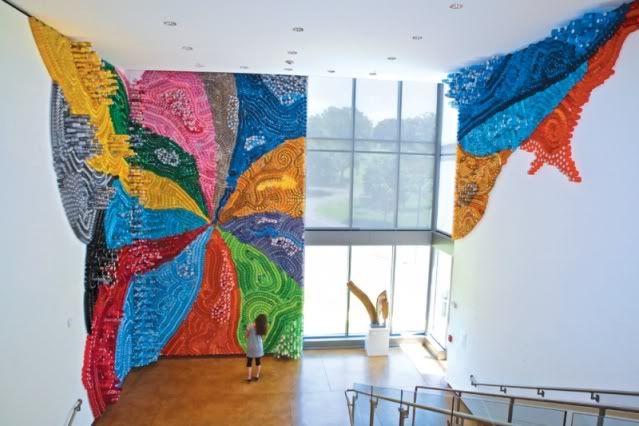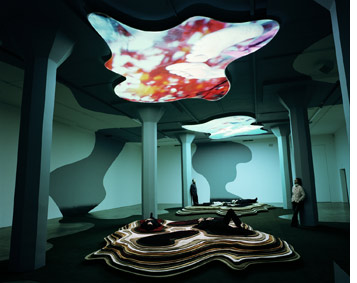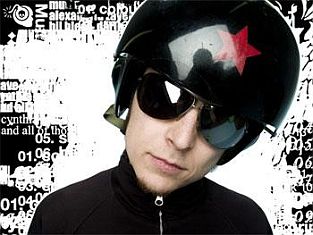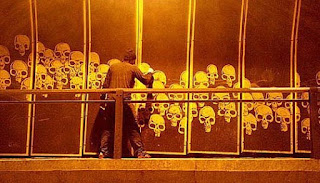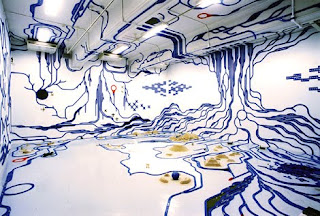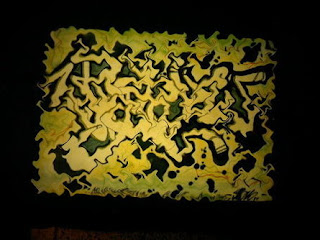Monday, April 26, 2010
My movie debut!
Even if I wasn't in it I would have enjoyed watching this movie. It's a high-quality production with great actors and a compelling topic. It was also especially interesting to me because it took place in Detroit and many of the settings were familiar.
Here's a great little HBO promo that features the actors talking about their roles and some of the actual characters, including Jack Kevorkian.
Behind The Scenes
Wednesday, April 21, 2010
It's a GIRL !!
Monday, April 19, 2010
Light Drawing - How to Do Light Graffiti

One hot new trend in photography is a technique called "light drawing" or "light graffiti." You've probably seen it in photos, videos, print ads, and even TV commercials. The process basically involves using long exposures in a dark area with a digital camera and LED or other light sources.
Unlike typical graffiti, this technique isn't illegal and doesn't cause property damage. It's essentially another form of time-lapse photography.
Before you start, make sure you have a digital camera that had manual settings. Some smaller/cheaper point-and-shoot cameras don't have this option. You'll need to change the shutter speed so that it stays open longer. And as stated previously, you'll need a light source (LED, flash light, glow stick, etc). A tripod also comes in handy because the camera needs to stay still while taking the shot.
Change the settings so the ISO is 100, the shutter is open to the widest aperture, disable the flash, and the exposure should be 10-30 seconds. You will also want to set a timer so you have time to get in front of the camera.
Hit the button on your camera to start taking the picture and get in front of the camera with your light source. If you set a delay, you might want to wait until the timer is up if you're drawing something specific (like letter, for example). When you're ready, start waving the light source around to "draw" your graffiti.
As you move around, your body will end up being a blur or ghost like figure in the actual photo (if at all). The light source will create streaks of light. You can draw shape, letters, and other designs. Just use your imagination and experiment with it.
One technique you can try is having another person stand perfectly still in the photo while you draw around them. You can point the light source at your face or other objects to create interesting reflections in the photo.
It's a lot of fun creating light graffiti in public because nobody will complain about your "drawings." They only exist in the photograph. You might even get some strange looks from people who have no idea why you're waiving a light at a camera!
For best results, use a good digital camera. Check out these digital camera reviews, and in particular, the Canon camera reviews.
Reverse Graffiti
 How to Graffiti - Reverse Graffiti
How to Graffiti - Reverse GraffitiIt is currently taking form via guerrilla marketing all over the world. As competition with businesses escalates to a more global position, the standards of current advertising campaigns are growing old.
Advertisers are now scrambling to form new ways to grab peoples attention over the television ads that used to work so well. Recent CBS reports have suggested that a person could see up to 5000 advertisements in a single day, wearing on a mind, and making the world hesitant to buy any product through an advertisement.
Marketers need to find new ways to stand out.
How To Graffiti: Reverse Graffiti
One new advantageous method of advertising that seems to have taken popularity with marketers has been with the use of reverse graffiti. Reverse graffiti is the concept of a non-damaging form of graffiti (i.e.: Reversible). It allows for people to leave messages, without the defacement of any property. Many of these forms of graffiti are literally cleaning art into surfaces.
It creates art, while cleaning the environment.
It makes an important statement.
There are many forms for this reverse graffiti, and I will discuss some of the more common methods below. Please note that these forms of graffiti are simply described here for informational purposes. It is intended that if you use this information to create your own street art, you do so on your own property, or you receive permission to do this on another's property.
Dust Tagging
Perhaps the most popular of all of the forms of reverse graffiti, dust tagging involves removing dust/grime from surfaces, typically with a cloth and some soapy water. Basically, an artistic dusting, as you literally clean your images into the surfaces of objects. Dust tagging has also evolved to include cleaning compacted dirt that layers on roads, though the dirt is typically packed onto the road more tightly - a power washer is required to lift up an image.
Dust tagging is common to be placed on opaque walls, or transparent surfaces, allowing for the dust vs. clean to really contrast with each other.
Moss Graffiti
Horticulturists discovered a way to create a "moss paint" to paint on surfaces. This paint once prepared, paints a layer of moss and nutrients on any surface. Under the proper growing conditions (shady and moist areas), the moss paint grows out to a fully grown moss, in 2 weeks. It also keeps the original design of what you painted! The texture adds a sharp contrast to any design, and it remains a fantastic, eco-friendly way to create graffiti.
Smog Graffiti
This form of reverse graffiti has been around since around 1991, and involves leaving stencils on buildings for long amounts of time (2 months or longer). It is a stencil art, without the paint. This is mainly a "city-only" type of graffiti, as cities are typically the only places with consistent amounts of smog to layer up on the sidewalks and streets. When you finally remove the stencil, there is a contrasting design of all the smog pile-up vs. the cleaner surface of the covered building.
Light Graffiti
Light graffiti is something that seems like it never stopped evolving. There have been multiple forms of light graffiti, from using projectors to cast images onto buildings from far away distances, to using cameras with slow exposure times in order to manipulate pictures while they are being taken.
Projectors - Created by the Graffiti Research Lab, the forms of this involve a laptop/projector combination hooked up to a car battery, or electrical outlet. The computer has software to design your own graffiti tag, and allow the projector to be cast onto buildings.
Cameras - Made popular recently by the rework by Michael Bosanko, this form of light graffiti involves a camera with a long exposure time (can be 10 seconds, up to an hour). By having a long exposure time, you also have the time to run into a picture being recorded, and manipulate the environment with light. You never physically touch the environment, and are left with awesome photos of a manipulated setting.
Though these are more common methods, the concept is to bring a sort of compromise with both sides of graffiti: to be allowed to have a street art, but to avoid damaging any property. This creates an interesting dynamic, as it allows marketers to more easily enter a cultural art form that at one point in time was deemed inaccessible (mainly illegal) to businesses. The fact that marketing with graffiti has been viewed as taboo as it was, allows for companies who use these techniques now to really stand out among fellow advertisers.
Everything that is created with reverse graffiti can easily be removed, whether it is by flipping a switch to turn off a light, or using a light soap and water combination to clean the entirety of a surface. Not only easily cleanable, it remains more environmentally friendly than many artistic ventures.
If any of this has really grabbed you, I really suggest getting out there and trying it! Reverse graffiti is another great way to not only learn a new street art, but to also look into one of the future areas where marketing will inevitably head.
Ziggy Chu is a graffiti enthusiast, and working performance artist. He is currently finishing a bachelor's degree in Chemical Engineering and studying in Stockholm, Sweden.
The websites below follow Ziggy's own experiences and recommendations with all forms of graffiti. Check them out now to learn more on how to graffiti!
Friday, April 16, 2010
Friday Favorite Photo: Spring 1949
 This photo of my mother was taken in Cambridge, England when she was 18 years old. It's one of a series of three photos that were taken the same day. On the back of this one she's written: "Me with horse. Cambridge, Spring 1949."
This photo of my mother was taken in Cambridge, England when she was 18 years old. It's one of a series of three photos that were taken the same day. On the back of this one she's written: "Me with horse. Cambridge, Spring 1949."Over the years I've had to piece together what I know about my mother's life from photographs, letters, documents, and the few family stories I've heard.
I especially love the three little photographs taken in Cambridge because they depict what I assume was a happy day in my mother's young life, and because she's written on the back of them:

"This was taken the day Pauline and I went to Cambridge. The horse nearly got my primroses!"

"Pauline's and my day in Cambridge. We have just been picking primroses in a wood. The country side was pretty and fresh after London."
Born in England, my mother spent most of her girlhood, the years of WWII, apart from her family. She and her siblings were sent to the safety of the country for "the duration." When she was 19 she traveled to the United States with a military family as their nanny - which is how I came to be born here.
This picture makes me wonder what led my mother and her friend, Pauline, to travel to Cambridge that Sping day in 1949. Did they have some business to attend to, were they visiting someone, or was it just a lark? I'll never know & I'm sure it's not important, but I'm glad she was photographed that day.
Wednesday, April 14, 2010
Another loss in the video rental war
 Until just recently this was the closest Blockbuster to my new home. It closed down a few weeks ago, another victim of the evil Netflix, and what a sad, sad thing.
Until just recently this was the closest Blockbuster to my new home. It closed down a few weeks ago, another victim of the evil Netflix, and what a sad, sad thing.I love video rental shops: strolling the racks of new releases, holding the actual DVD cases in my hands, being among other happy DVD renters, and maybe even exchanging a few pleasant words with the staff.
Why would I want to trade that for more time at my computer and getting movies in the mail I might not even be in the mood to see? I just don't get it.
What if I'm in the mood for a comedy, but a slew of drama's have come up on my "queue"? I'd so much rather pick out a movie I'm in the mood for WHEN I'm in the mood for it. And I'd so much rather deal with a real place and real people than another cyber-shop.
Thankfully there's a "Family Video" near me, a great DVD section at my library, and another Blockbuster not too far away and still in business - for now.
Tuesday, April 13, 2010
New rug for the dining room
 We recently solved the problem of finding a rug for our dining area to compliment the one in the living room by buying an identical rug! And why not? They're beautiful and I think they look great together - we might even get a matching runner for the hall.
We recently solved the problem of finding a rug for our dining area to compliment the one in the living room by buying an identical rug! And why not? They're beautiful and I think they look great together - we might even get a matching runner for the hall.We'll probably never have another house where we'll find a use for both these rugs - especially since we keep saying our next house will be our retirement condo - but they sure do work for this house, and might just become family heirlooms. Since I have twin sons I can will one to each!
It's a rainy day. Those are my "school books" on the table. I should be reading and thinking. But I'm doing this instead.
Monday, April 12, 2010
Galileo

Today is the day (in 1633) that Galileo stood trial before the Roman Inquisition to defend the publication of his book about the Copernican view of the universe.
This revolutionary idea (that the Earth and other celestial objects revolved around the sun) was at odds with the understanding - legitimized by the church - that Earth was the center.
The pope condemned Galileo to imprisonment, banned his book from publication, and forbid him to speak or write on the mobility of the Earth or stability of the Sun. It wasn't until 1822 that the church's ban on Galileo's book was lifted. And it wasn't until 1992 that the church expressed regret and acknowledged it's errors concerning Galileo. (Funny how a guy who is supposedly infallible could actually be wrong.)
Thursday, April 8, 2010
Spring Bouquet

This is the first bouquet of the year from our new garden. I've never had hyacinths before - how nice they look with the daffodils. Our yard has a lot of potential, but needs a lot of work. I feel the fever coming on to be out there digging in the dirt, but there are too many other priorities right now.
Tuesday, April 6, 2010
Graffiti Design – Art or Vandalism?
Defining art is a difficult task. Who is to say what constitutes a good piece of art? It is a highly subjective matter with few guidelines to go by. Some people think of art as paintings of nature, people, or bowls of fruit. Others think art is anything that moves you. Between all the traditional and radical interpretations of what makes a piece of art or design successful, one must look at graffiti and wonder – is this art or simply vandalism?
Living in the city of Toronto, you’re bound to see graffiti. Many of Toronto’s walls and buildings are covered in graffiti. The designs range from a few words simply spray-painted on the wall, to the most ornate and detailed.


These designs are what fill in all the gaps and spaces of the city. In between corporate buildings and alleyways, graffiti artists find a place and a way to express themselves with a few tools and imagination. Still, graffiti used to be cast in a very bad light. Graffiti artists were not seen as artists. They were nothing more than society’s angry outcasts, professional vandals who defaced public property just for the hell of it.
Today, graffiti has garnered a lot more respect and appreciation. It seems that some people enjoy graffiti; they even think it is beautiful. The fact that graffiti artists are referred to as artists shows just how much public perception of these designs has changed. Graffiti has been embraced in a new way. There are websites dedicated to the collection of graffiti photos, online galleries to display what graffiti artists have to offer. There are graffiti stores that cater to graffiti artists by selling all the supplies they need, from spray paint and canvasses to the right clothing and customs products.
However, I wouldn’t hold my breath for graffiti to ever be fully accepted by society. It may have its admirers and its own art galleries but these galleries are online, in that virtual cyberspace where they can’t be touched. I don’t know if graffiti will have its own art museums, and if they did, I doubt they would have the same kind of prestige or reputation as a traditional art gallery would. While many citizens think of graffiti as art peppered across their home town, authority figures think of it as another problem to be dealt with. The police, the city of Toronto, and dozens of graffiti removal companies are all putting a lot of money and time into stripping the city of graffiti.
I find it interesting that the location of a design can be the factor that defines what that design is – a nuisance, or something beautiful. That location being on the side of a building or on a canvas at home is the deciding factor. Of course I can see why graffiti is removed – the bottom line is that these buildings do not belong to the graffiti artists. It is not their property to design on. At the same time, that artist’s voice inside me thinks there is something almost romantic about a city being used as a canvas to express someone’s beliefs and passions, while giving citizens a bit of beauty to gaze at in between all the grey buildings.

Driving the demon out of Detroit
 I'm so sorry I missed this! On March 21st a group of Detroiters revived a tradition of driving a demon, the Nain Rouge, out of the city. Not that I believe in demons, but what fun! I'm all for anything that might improve the spirit of Detroit.
I'm so sorry I missed this! On March 21st a group of Detroiters revived a tradition of driving a demon, the Nain Rouge, out of the city. Not that I believe in demons, but what fun! I'm all for anything that might improve the spirit of Detroit.According to legend the Nain Rouge, or red dwarf, has been plaguing the city since the 1700s. The two-foot tall evil gnome has supposedly made appearances before every awful event in Detroit's history.
To ward off his bad luck an annual parade, called Le Marche du Nain Rouge, was traditionally held in the spring to banish him from the city. The first parade was in 1710.
I grew up in Detroit and think I know a lot about the place, but yesterday was the first time I'd ever heard of this.
Two-hundred people showed up for the 300th anniversary parade on March 21st. It culminated with burning the Nain Rouge in effigy & I really wish I would have been there. You can read more about it here.
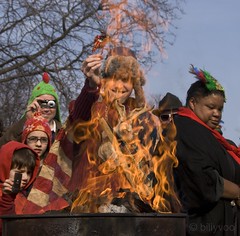
Marche du Nain Rouge - Burning of the Effigy
Originally uploaded by billyvoo
Friday, April 2, 2010
Friday Favorite Photo: Easter 1960
 Here I am at the age of five, all dressed up for Easter. My dress is flipped up behind me because that was my idea of being really fancy. There are a couple of photos of me as a little girl with my dress flipped up like this. I felt very princess-like with my finery displayed about me.
Here I am at the age of five, all dressed up for Easter. My dress is flipped up behind me because that was my idea of being really fancy. There are a couple of photos of me as a little girl with my dress flipped up like this. I felt very princess-like with my finery displayed about me.Just look at that satisfied expression on my face. I'm wearing a pretty new dress, my hair has been cut and curled, and I've been given a giant basket of candy.
I don't celebrate Easter now, but sure loved it when I was a kid. It was all about me!
Thursday, April 1, 2010
Street Scene: How To Draw Graffiti-Style

Create your own slammin', street-smart comic art!
Contains 28 step-by-step demonstrations in an edgy, high-impact style.
Whether you're an aspiring comic-artist or you just wanna have fun drawing ... this book shows you how to rock it out in your own gritty, graffiti-influenced style. Start with simple shapes and stick figures and build up to full, fleshed-out dudes and babes with serious attitude!
Draw a radical cast of 18 characters step by step, including hip hop artists, rappers, graffiti artists, DJs, skatekids, BMX riders, basketball players, snowboarders, Goth girls, fashionistas, punk rockers, and other urban subculture types.
Express your characters' style with the coolest hairstyles, clothing, shoes, bling, hats, glasses, bags, piercings, tattoos and gear.
Let your characters kick it in ultra-cool environments, from gritty cityscapes and zany interiors to wild and abstract backgrounds.
From feet to facial expressions, you'll get lots of expert tips for awesome results. It's everything you need to create maximum-impact art that expresses your own sense of style and individuality ... Art that says, "I was here!" About the Author
John Lee describes his "style" as a melding of manga and old-school American animation with a dab of street graffiti mixed in. Born in Seoul, South Korea, he now lives in Flushing, New York, his inspiration coming from his Eastern origins combined with his western influences.
